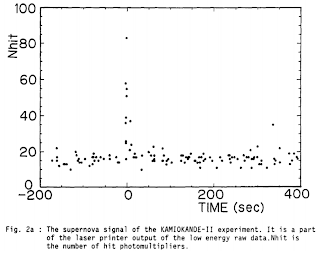Neutrino Astrophysics: Supernova 1987A
, 3 min, 565 words
Tags: physics neutrinos astrophysics
Apart from the neutrinos from the Sun, we can also observe neutrinos from high-energy cosmic events. The best example of this is supernova 1987A, a stellar explosion in the Large Magellanic Cloud, a nearby galaxy, whose light reached us in February of 1987.
As we've seen, in the early stages of a supernova, the iron core's electron degeneracy pressure isn't enough to oppose gravitational collapse, and electron capture ensues, in which the reaction $p+e^-\rightarrow n+ \nu_e$ turns the core into an enormous atomic nucleus called a neutron star. This produces a huge flux of neutrinos. And to make matters even more interesting, as these neutrinos propagate through the incredibly dense core, they lose energy, much of which is released in the form of neutrino-antineutrino pairs. (At least, that's what I get from reading bits and pieces of the literature on the subject.) The net result is an immense flux of neutrinos heading away from the collapsing star. Outside the extremely dense core, the neutrinos can happily propagate through just about everything, whereas light from the ensuing explosion has to bounce around for quite a while before escaping. As a result, the neutrinos leave the immediate vicinity of the star long before the actual light, and carry well over 95% of the collapse's total energy.
Luckily for astrophysicists, there were several neutrino detectors in operation on February 23, 1987. These detected an enormous flux of neutrinos for a short period of time. In fact, Kamiokande-II saw such high detection rates that they were able to use more of their detector than usual for detection, because the background was such a low fraction of events compared to normal.* Just because I found this figure, I'm going to inflict it on you as well. It's the original data from Kamiokande-II showing the huge number of events. They detected 11 events in a matter of minutes, as compared with just a couple each day under normal circumstances. Another neutrino detector, IMB, near Lake Erie, detected 8 neutrinos at the same time.

Furthermore, these neutrinos were detected around three hours before the light from the explosion reached Earth, which confirms once again how awesome neutrinos are as astrophysical tools. It also allowed physicists to place upper limits on the mass of the neutrino, since more massive particles would have had to travel much slower than light, and would likely have been overtaken by the explosion's light on the way to Earth.
* The way that Kamiokande operates, as far as I can tell, is that it only uses the central portion of the water chamber. The outer layers are simply there to filter out background, like cosmic rays and radiation from detectors or other nearby objects. Only a small portion can be used for the real detection of neutrinos because of the incredibly low interaction rates. Any false positives would have a major impact on the resulting data.
This is the fifth post in a series on neutrino astrophysics. Other neutrino-related posts can be found here.